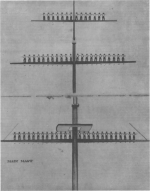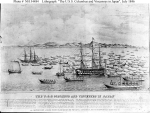Specifications:
Displacement 2,480 t.
Length 191' 10"
Beam 53' 6"
Draft 26' 6"
Speed unknown
Complement 780
Armament
| Click On Image For Full Size Image |
Size | Image Description | Contributed By |
|
|---|---|---|---|---|
 |
8k | Sketch of USS Columbus, date unknown, from DANFS | US Naval History and Heritage Command | |
 |
138k | Master sailmakers plan of the USS Columbus (II). from "The History of the American Sailing Navy: The Ships and Their Development, New York" by Howard I. Chappelle: W. W. Norton and Company, Inc., 1949, unattributed, apparently from U.S. National Archives |
Robert Hurst | |
 |
35k | Illustration for manning the yards, photographed from Watch, Quarter and Station Book, Ship-of-the-line USS Columbus. Illustrations were in color, drawn by an unnamed ship's yeoman, in 1847. From DANFS | US Naval History and Heritage Command | |
 |
99k | Picture depicting the First U.S. Navy visit to Japan, July 1846. This is a copy made by Mr Renjo Shimo Oka from an original Japanese painting, depicting USS Columbus and USS Vincennes anchored in Yeddo (Tokyo) Bay, Japan, circa 20-29 July 1846. They were under the command of Commodore James Biddle, US Naval History and Heritage Command photo # NH 63523. |
Robert Hurst | |
 |
166k | "The U.S.S. Columbus and Vincennes in Japan". Contemporary lithograph published by Wagner & McGuigan, based on sketches by John Eastly. It depicts USS Columbus (right center), flagship of Commodore James Biddle, and USS Vincennes (left) anchored in Jeddo Bay, Japan, circa 20-29 July 1846. They are surrounded by a fleet of Japanese small craft, which acted to prevent the ships from communicating with the shore. Courtesy of Mrs. Macomb, Washington, D.C., circa 1920. Caption at the bottom of the sketch reads "On the 20th of July 1846, the U.S. Ships Columbus & Vincennes entered the Bay of Jeddo or (as the Japanese call it) Yeddo. The Ships stood well up the Bay until the Japanese, who had come on board, mentioned that they must not proceed further, and the Commodore not wishing to give offense anchored abreast a village, and about three miles from the shore. As soon as the Ships anchored they were surrounded by a large number of boats from whose warlike appearance much difficulty was not anticipated. Shortly after the sails were furled, the Commanders were politely requested to land their guns, ammunition, muskets & everything in the shape of a weapon, which request was as politely refused. The Anchorage was about 15 miles to the S(outh) and E(ast) of Yedo, which was hidden by a high point of land making out into the Bay. The Country around was beautifully green and the fields as well as could be distinguished from the ships were in fine order and to all appearance well cultivated. No person was allowed to land; and boats passing between one ship and the other were always followed by at least four Japanese armed boats to prevent their landing; and therefore there was no good opportunity of judging as to what the real state of the country might be. The visit altogether was one of the most novel kind. The people polite, amiable and exceedingly jealous of their customs, and adhered strictly to the long established one of not receiving the slightest remuneration for anything that they gave. The visitors were politely informed that as soon as their wants were made known they would be attended to and that done they were desired to leave and never return again. The Ships sailed from there on the 29th after an interesting stay of nine days, during which time hundreds of Japanese visited the Ships, and to hasten their departure, formed a line of several hundred boats to tow the vessels out to sea, and left rejoicing that they had rid themselves so easily of such a number of Barbarians." US Naval History and Heritage Command photo # NH 54484. |
US Naval History and Heritage Command | |
USS Columbus (II)
Dictionary of American Naval Fighting Ships (DANFS)
| Back To The Navsource Photo Archives Main Page | Back To The Old Navy" Steam and Sail Index |
| Comments, Suggestions, E-mail Webmaster. |
|
This page is created and maintained by Gary P. Priolo |